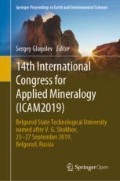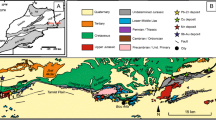Abstract
The Cerattepe mine, one of the volcanogenic massive sulfide deposits in northeastern Turkey, is hosted within the late Cretaceous volcanic, intrusive and sedimentary rocks. Deposit’s main ore body contains high-grade massive copper sulfides and a gold-silver and barium rich oxide zone, characterized by dense alteration stages, is situated on top of it. Replacement, cataclastic, breccia, dissemination, dendritic, concentric growth, colloform, and framboidal textures were identified. Pyrite, sphalerite, marcasite, chalcopyrite, bornite, galena, tennantite-tetrahedrite, gold, covellite, digenite, chalcocite, cuprite and cubanite constitute the mineral paragenesis where quartz, calcite and barite account for the gangue minerals. Limonite, hematite, lepidocrocite, malachite, azurite and jarosite developed in the oxidation zone.
You have full access to this open access chapter, Download conference paper PDF
Similar content being viewed by others
Keywords
1 Introduction
The eastern Pontide orogenic belt of Turkey is an important segment of the Tethyan-Eurasian Metallogenic Belt. This belt carries a special importance in metallogeny of Turkey and hosts numerous VMS deposit. (Akıncı 1984; Çiftçi and Hagni 2005; Güven 1993; Revan et al. 2013; Zaykov et al. 2006; Yiğit 2005). The most of the eastern Pontide VMS deposits show some similarities in many aspects to the Kuroko deposits of Japan (Çiftçi and Hagni 2005; Ciftci 2000; Pejatoviç 1979). The Cerattepe Deposit is a Kuroko-type VMS deposit located in late Cretaceous age volcanic, intrusive and sedimentary rocks. It is distinguished by an unusual basal zone of high-grade copper sulfides and an overlying Au-rich oxide zone from the other VMS deposits of northeastern Pontides.
2 Methods and Approaches
A total of 46 samples representing oxide (14), sulfide (28) and stringer zones (4) of Cerattepe ore deposit were collected from drill cores, underground audits and surface outcrops. Polished sections were prepared and Nikon Eclipse LV100 reflected light microscopy was employed for examination. The ore minerals and the paragenesis were identified on the basis of their petrographical features and their textural relationships, respectively. Electron Probe Micro Analysis (EPMA) and Secondary Electron Microscopy-Energy Dispersive Spectroscopy (SEM-EDS) were used for chemistry of sulfide minerals.
3 Results and Discussion
The mineral paragenesis (Fig. 1) of Cerattepe VMS deposit comprises of pyrite, sphalerite, marcasite, chalcopyrite, bornite-idaite, galena, covellite, chalcocite, cubanite, cuprite including sulfosalts (mainly tennantite and lesser tetrahedrite) gold, silver, arsenopyrite and bournonite.
Gangue minerals include barite, quartz, gypsum, anhydrite and calcite. Hematite, limonite, lepidocrocite, malachite and azurite, and jarosite are the oxidation minerals. Four generation of pyrite is specified. Pyrite I is represented by colloform-concentric textured (Fig. 2) grains formed from initial solution reached the seafloor from the chimney. The colloform textured pyrites are progressively overgrown later coarse crystalline grains, which are the second generation pyrites.
Photomicrographs of selected polished sections showing observed textures in Cerattepe deposit. (a) Cataclastic texture of pyrite grains. (b) Colloform textured pyrite and marcasite intergrowth surrounded by sphalerite “Bird’s eye texture”; (c) Colloform textured pyrite aggregate with a spongy textured intergrowth zones comprised of sphalerite, galena and tetrahedrite; (d) Three different generation of pyrites, (e) Pelletal pyrite framboids with minor sphalerite and galena in the cracks; (f) Bornite and chalcopyrite replaced by covellite; (g) collomorphically banded sulfides in melnikovite pyrite; (h) Dissociation texture of chalcopyrite in sphalerite replaced by marcasite
These are later extensively altered to marcasite. The framboidal-pelletal textured collomorphic grains, seen sometimes coeval with sphalerite and galena, are the third generation pyrites. The fourth generation pyrites are small sized euhedral, subhedral grains observed on transition zone of sulfide ore- footwall rock and veinlets of stringer zone.
Most of the minerals are small - fine grained, and the larger grains of the major minerals are in the order of 100–800 µm up to 1.2–2 mm in size and some rare pyrite grains have a size of 5 mm. Most of the minor and trace minerals are much smaller, typically in the order of 1–20 µm in size. Majority of ore minerals are anhedral with the exception of pyrite, quartz, barite and some sphalerite and galena occur as euhedral to subhedral crystals. Observed ore textures are dissemination and veinlet textures in the stockwork and siliceous ore zones, whereas replacement, overgrowth, concentric and colloform textures become prevalent in the massive ore, particularly in the center of main deposit.
Banded textures of black and yellow ore are seen with polymetallic sulfides. In the outer part of the main ore body, at lateral zones, clastic or fragmental ore textures are present.
4 Conclusions
It is concluded that the ore mineral assemblage and textures observed in Cerattepe VMS deposit are comparable to those of other VMS deposits occur in north eastern Pontide region, Kuroko deposits of Japan and also comparable modern seafloor–seamount VMS deposits in the world.
References
Akıncı ÖT (1984) The geology and the metallogeny of the Eastern Pontides (Turkey). In: International world geological congress abstracts, pp 197–198
Ciftci E (2000) Mineralogy, paragenetic sequence, geochemistry, and genesis of the gold and silver bearing upper cretaceous mineral deposits, Northeastern Turkey. Ph.D. Thesis, University of Missouri-Rolla, Rolla, MO, USA (unpublished)
Çiftçi E, Hagni RD (2005) Mineralogy of the Lahanos deposit a Kuroko-type VMS deposit from the eastern Pontides (Giresun, NE Turkey). Geol Bull Turk 48(1):55–64
Güven İH (1993) Artvin Kafkasör Sahası Maden Jeolojisi Raporu No 2600, MTA, Ankara. metallogeny. Ore Geol Rev 147–179
Pejatovic S (1979) Metallogeny of the Pontid type massive sulphide deposits, Ankara, 98 p
Revan MK, Genç Y, Maslennikov V, Ünlü T, Delibaş O, Hamzaçebi S (2013) Original findings on the ore-bearing facies of volcanogenic massive sulphide deposits in the eastern black sea region (NE Turkey). Bull MTA 147:73–89
Yigit O (2005) Gold in Turkey - a missing link and metallogenic features of the in Tethyan
Zaykov V, Novoselov K, Kotlyarov V (2006) Native gold and tellurides in the Murgul and Çayeli volcanogenic Cu deposits (Turkey)
Acknowledgements
This study was financially supported by BAP Project unit (No: 39615) of Istanbul Technical University in Turkey. We are thankful to Mr. Ünsal Arkadaş and staff of Etibakır A.Ş. in Artvin, Turkey for their courteous support for the field work.
Author information
Authors and Affiliations
Corresponding author
Editor information
Editors and Affiliations
Rights and permissions
Open Access This chapter is licensed under the terms of the Creative Commons Attribution 4.0 International License (http://creativecommons.org/licenses/by/4.0/), which permits use, sharing, adaptation, distribution and reproduction in any medium or format, as long as you give appropriate credit to the original author(s) and the source, provide a link to the Creative Commons license and indicate if changes were made.
The images or other third party material in this chapter are included in the chapter's Creative Commons license, unless indicated otherwise in a credit line to the material. If material is not included in the chapter's Creative Commons license and your intended use is not permitted by statutory regulation or exceeds the permitted use, you will need to obtain permission directly from the copyright holder.
Copyright information
© 2019 The Author(s)
About this paper
Cite this paper
Akpınar, İ., Çiftçi, E. (2019). Ore Mineralogical Study of Cerattepe Au-Cu (±Zn) VMS Deposit (Artvin-Turkey). In: Glagolev, S. (eds) 14th International Congress for Applied Mineralogy (ICAM2019). ICAM 2019. Springer Proceedings in Earth and Environmental Sciences. Springer, Cham. https://doi.org/10.1007/978-3-030-22974-0_2
Download citation
DOI: https://doi.org/10.1007/978-3-030-22974-0_2
Published:
Publisher Name: Springer, Cham
Print ISBN: 978-3-030-22973-3
Online ISBN: 978-3-030-22974-0
eBook Packages: Earth and Environmental ScienceEarth and Environmental Science (R0)






